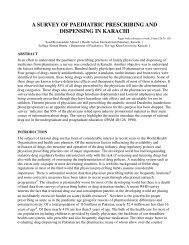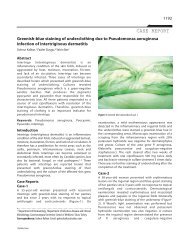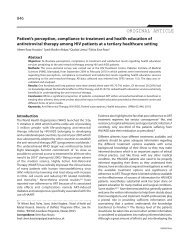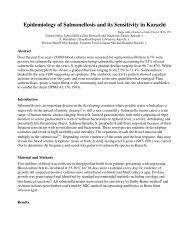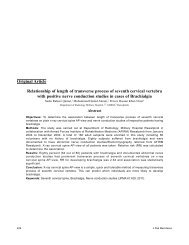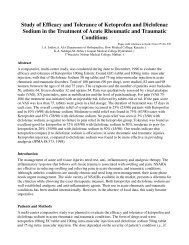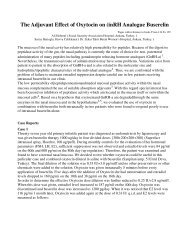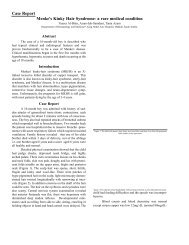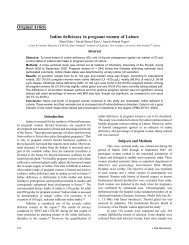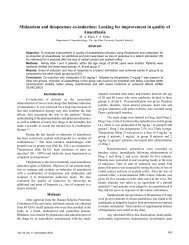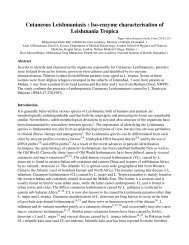Strangulated Inguinal Hernia: an Unusual Presentation - Journal of ...
Strangulated Inguinal Hernia: an Unusual Presentation - Journal of ...
Strangulated Inguinal Hernia: an Unusual Presentation - Journal of ...
You also want an ePaper? Increase the reach of your titles
YUMPU automatically turns print PDFs into web optimized ePapers that Google loves.
<strong>Str<strong>an</strong>gulated</strong> <strong>Inguinal</strong> <strong>Hernia</strong>: <strong>an</strong> <strong>Unusual</strong> <strong>Presentation</strong><br />
M.H.R. Haider ( Teaching Surgical Unit Ill, Department <strong>of</strong> Surgery, Pakist<strong>an</strong> Institute <strong>of</strong><br />
Medical Sciences, Istamabad. )<br />
M. Ather,M. Iqbal,T. Khaliq ( Teaching Surgical Unit III, Department <strong>of</strong> Surgery, Pakist<strong>an</strong><br />
Institute <strong>of</strong> Medical Sciences, Islamabad. )<br />
Introduction<br />
The incidence <strong>of</strong> hernia is estimated to be 3 percent. 1 <strong>Hernia</strong> repair is one <strong>of</strong> the most<br />
common elective procedures in general surgery today, with <strong>an</strong> estimated 700,000<br />
inguinal herniorhaphies performed <strong>an</strong>nually in United Stated alone. 2 Groin<br />
herniorhaphies both elective <strong>an</strong>d emergency are the most common operations performed<br />
by the general surgeon. 3 A bulge in the groin situated above <strong>an</strong>d lateral to pubic tubercie<br />
is the usual presentation which c<strong>an</strong> become irreducible leading to incarceration <strong>an</strong>d<br />
str<strong>an</strong>gulation. Long st<strong>an</strong>ding large inguinoscrotal hernias may produce necrosis <strong>of</strong> scrotal<br />
skin due to pressure. 4<br />
We present a patient <strong>of</strong> long st<strong>an</strong>ding neglected inguinoscrotal hernia presenting in the<br />
emergency with necrosis <strong>of</strong> hernia sac <strong>an</strong>d scrotal skin leading to protrusion <strong>of</strong><br />
g<strong>an</strong>grenous small intestine. Patient was operated upon after active resuscitation.<br />
Resection <strong>an</strong>d end to end <strong>an</strong>astómosis <strong>of</strong> the small intestine midline celiotomy <strong>an</strong>d<br />
Bassini’s repair <strong>of</strong> the hernia was performed. Patient made a delayed but full post<br />
operative recovery.<br />
Case Report<br />
A 60 years old m<strong>an</strong> was brought to the casualty <strong>of</strong> PIMS (Pakist<strong>an</strong> Institute <strong>of</strong> Medical<br />
Sciences Islamabad) with history <strong>of</strong> foul smell em<strong>an</strong>ating from the patient who was<br />
living alone in a small house. He was picked up by his neighbor as he was not seen out <strong>of</strong><br />
his house for the last few days. At the time <strong>of</strong> presentation he was severely dehydrated,<br />
<strong>an</strong>d was not responding to vocal comm<strong>an</strong>d making communication extremely difficult.<br />
Physical examination revealed a heart rate <strong>of</strong> 130 per minute with low volume thready<br />
pulse, <strong>an</strong>d the blood pressure was 60/40 mm <strong>of</strong> Hg. He was resuscitated with intravenous<br />
fluids. Further examination revealed that almost whole <strong>of</strong> the small intestine was lying<br />
out <strong>of</strong> the peritoneal cavity over the upper <strong>an</strong>teromedial part <strong>of</strong> the left thigh <strong>an</strong>d most <strong>of</strong><br />
it was g<strong>an</strong>grenous. It was coming out <strong>of</strong> the necrosed scrotal skin from the left side.<br />
A diagnosis <strong>of</strong> str<strong>an</strong>gulated hernia with scrotal skin necrosis <strong>an</strong>d protrusion <strong>of</strong><br />
g<strong>an</strong>grenous small intestine was made <strong>an</strong>d immediate surgery was pl<strong>an</strong>ned.<br />
At operation there was a large area <strong>of</strong> scrotal skin necrosis with small intestine protruding<br />
out. The gut was g<strong>an</strong>grenous <strong>an</strong>d was covered with slough. The gut could be traced to the<br />
inguinal c<strong>an</strong>al.<br />
A midline celiotomy was performed <strong>an</strong>d resection <strong>of</strong> the g<strong>an</strong>grenous segment <strong>of</strong> small<br />
intestine (about 17 feet) followed by single layer end-to-end <strong>an</strong>astomosis was carried out.<br />
The remaining gut consisted <strong>of</strong> six feet (proximal segment) <strong>an</strong>d two feet <strong>of</strong> ileum distal to<br />
the <strong>an</strong>astomosis. <strong>Hernia</strong> repair was done by Bassini’s technique <strong>an</strong>d abdominal incision
was closed in single layer.<br />
Postoperatively patient required ventilatory support for which he was shifted to the<br />
intensive care unit. Postoperative period was complicated by abdominal wound infection<br />
requiring prolonged 1/V <strong>an</strong>tibiotics <strong>an</strong>d repeated ch<strong>an</strong>ge <strong>of</strong> dressings. Scrotal wound was<br />
left open after debridement to heal by secondary intention. Patient was tolerating oral<br />
liquids <strong>an</strong>d semisolids while in the hospital <strong>an</strong>d was discharged on oral elemental diet on<br />
11th postoperative day. Post-operative follow-up showed no signs <strong>of</strong> malnutrition, so<br />
total parenteral nutrition was not instituted.<br />
Discussion<br />
A hernia is a protrusion <strong>of</strong> normal cavity contents through the fascial <strong>an</strong>d muscular layers<br />
designed to contain them. The inguinal hernia results due to failure <strong>of</strong> various layers <strong>of</strong><br />
abdominal wall to contain enclosed viscera. Most common complaint in nearly all the<br />
patients, is the appear<strong>an</strong>ce <strong>of</strong> a lump in the groin. Sometimes, there is a dragging<br />
sensation or pain in the groin. In the beginning the hernia reduces itself after appearing on<br />
coughing straining or st<strong>an</strong>ding.<br />
Complications may develop in groin hernias, such as irreducibility <strong>an</strong>d obstruction, with<br />
or without str<strong>an</strong>gulation <strong>an</strong>d may convert <strong>an</strong> easily treatable condition into a lifethreatening<br />
emergency. Identification <strong>of</strong> risk factors that may predict complications<br />
would help place the patient in a high-risk group. Early admission <strong>an</strong>d surgery in such<br />
patients is associated with signific<strong>an</strong>t reduction in mortality <strong>an</strong>d morbidity. 5<br />
<strong>Inguinal</strong> hernia may become irreducible <strong>an</strong>d produce intestinal obstruction but<br />
str<strong>an</strong>gulation is the most feared complication requiring urgent surgical intervention.<br />
Str<strong>an</strong>gulation occurs due to impairment <strong>of</strong> the blood supply, which if partial, leads to<br />
venous congestion <strong>an</strong>d produces g<strong>an</strong>grene in cases <strong>of</strong> complete occlusion. <strong>Inguinal</strong><br />
hernias are more common, but it is femoral hernia, which is more prone to str<strong>an</strong>gulation.<br />
The incidence <strong>of</strong> str<strong>an</strong>gulation in inguinal hernia is up to 5% 6 The risk factors shown to<br />
be useful in predicting complications in <strong>an</strong> adult population are age (old age group),<br />
duration <strong>of</strong> hernia (short), type (femoral) <strong>an</strong>d co-existing medical illnesses. 5-7<br />
The exact precipitating cause <strong>of</strong> obstruction <strong>an</strong>d str<strong>an</strong>gulation is unknown but some<br />
events like straining coughing or sneezing may force the contents into the sac, which are<br />
gripped at the neck <strong>of</strong> the sac by the deep ring. The contents are swollen due to venous<br />
congestion with exudation <strong>of</strong> blood stained fluid. Swelling <strong>an</strong>d venous congestion<br />
impairs arterial supply <strong>an</strong>d g<strong>an</strong>grene ensues within 4-6 hours. Neglected cases may develop<br />
localized sepsis due to gut perforation, followed by generalized septicemia.<br />
Longst<strong>an</strong>ding large inguino-scrotal hernias are more common in the sliding variety <strong>of</strong><br />
hernias. Neglected cases (patients <strong>of</strong> nursing homes, hospices <strong>an</strong>d psychiatric wards) may<br />
develop necrosis <strong>of</strong> overlying skin. Sometimes the sac also sloughs <strong>of</strong>f resulting in the<br />
intestinal protrusion through the defect.<br />
In our patient, most <strong>of</strong> the small intestine (g<strong>an</strong>grenous) was protruding out <strong>of</strong> the sac <strong>an</strong>d<br />
was seen lying in front <strong>of</strong> upper thigh. The gut was g<strong>an</strong>grenous due to arterial <strong>an</strong>d venous<br />
occlusion at the level <strong>of</strong> the deep ring.<br />
This m<strong>an</strong> was <strong>an</strong> old psychiatric patient, living alone <strong>an</strong>d brought in obvious systemic<br />
sepsis. The most common reason for intestinal perforation is necrosis at the <strong>an</strong>te<br />
mesenteric border due to vascular compromise. But in large inguino-scrotal hernia, direct
trauma c<strong>an</strong> also cause perforation. 8<br />
It is recommended to perform st<strong>an</strong>dard laparotomy in str<strong>an</strong>gulated inguinal hernia, as<br />
proper resection <strong>of</strong> the gut after identifying the vessels, is only possible through<br />
abdominal incision. 9<br />
Intestinal resection <strong>an</strong>d <strong>an</strong>astomosis was performed through midline celiotomy <strong>an</strong>d<br />
Bassini’s repair was performed for hernia, scrotal wound was packed after debridement.<br />
Post operatively, patient made slow but steady recovery.<br />
In the revolutionized era <strong>of</strong> surgery <strong>an</strong>d <strong>an</strong>esthesia such a case is rarely seen. Although<br />
conservative treatment may be instituted in a frail old patient but the dreaded<br />
complication <strong>of</strong> str<strong>an</strong>gulation <strong>an</strong>d g<strong>an</strong>grene makes it a less desired option to such <strong>an</strong><br />
extent that some countries have adopted the policy <strong>of</strong> operating all hernias. 10<br />
Elective hernia repair in frail <strong>an</strong>d elderly patients, even those on continuous ambulatory<br />
dialysis, have been shown to be associated with less mortality as compared to<br />
conservative treatment. 11<br />
So all patients with hernias need special attention regarding risks for str<strong>an</strong>gulation <strong>an</strong>d<br />
should be admitted <strong>an</strong>d operated on priority to prevent morbidity <strong>an</strong>d mortality<br />
<strong>an</strong>astomosis associated with the resection <strong>of</strong> g<strong>an</strong>grenous gut <strong>an</strong>d <strong>an</strong>astomosis.<br />
References<br />
1.Lichtenstein IL. <strong>Hernia</strong> repair without disability. 2nd ed.St Louis, Mo: ishlyaku<br />
Euroamerica Inc; 1986, chap.2.<br />
2.Rutkow IM.Surgical operations in the United States; then (1983) <strong>an</strong>d now (1994). Arch<br />
Surg 1997; 2:113-29.<br />
3.Kingsworth A. Bennet DH. <strong>Hernia</strong>s, Umbilicus: abdominal wall. In: Russell RCG,<br />
Williams NS, Bulstrode CJK (eds). Bailey <strong>an</strong>d Love Short Practice <strong>of</strong> Surgery 23rd ed.<br />
London: Arnold, 2000 p. 1149.<br />
4.Giles GR, Halasz NA. The Abdominal Wall <strong>an</strong>d <strong>Hernia</strong>s. In: Cuschieri A, Giles GR,<br />
Moossa AR(eds). Essential Surgical Practice 3rd ed. London: Butterworth-Heinern<strong>an</strong>n,<br />
1995, p. 1445.<br />
5.Rai S, Ch<strong>an</strong>dre SS, Smile SR. A study <strong>of</strong> the risk <strong>of</strong> str<strong>an</strong>gulation <strong>an</strong>d obstruction in<br />
groin hernias. Aust NZJ Surg 1998;68:650-4.<br />
6.Uppot RN, Ghey VK, Gupta R, et at. Intestinal perforation from blunt trauma to<br />
inguinal hernia. Am J Roentgenol 2000;174:1538.<br />
7.Chaloner EJ. Deineuvilie J. External str<strong>an</strong>gulation <strong>of</strong> the small bowel following injury<br />
to inguino-scrotal hernia. Injury 1997;28:69-70.<br />
8.Horb<strong>an</strong> VR, Merliuk VO, Arsenink VV, et at. <strong>Str<strong>an</strong>gulated</strong> intramural ingtiinal hernia.<br />
Kiln Khir 1998;3:53.<br />
9.Devlin HB. <strong>Inguinal</strong> hernia in adults. In: Dudley H (ed) Rob <strong>an</strong>d Smith operative<br />
surgery 4th ed. London: Butterworth-Heinem<strong>an</strong>n, 1983, p. 465.<br />
10. Millat B. Treatment <strong>of</strong> inguinal hernia. Rer Prat 1997,47:268-72.<br />
11. Morris-Stiff GJ, Bowrey DJ, Jurewicz WA, et at. M<strong>an</strong>agement <strong>of</strong> inguinal hernia in<br />
patients on continuous ambulatory peritoneal dialysis: <strong>an</strong> audit current UK practice.<br />
Postgrad Med J 1998;74:669-70.



